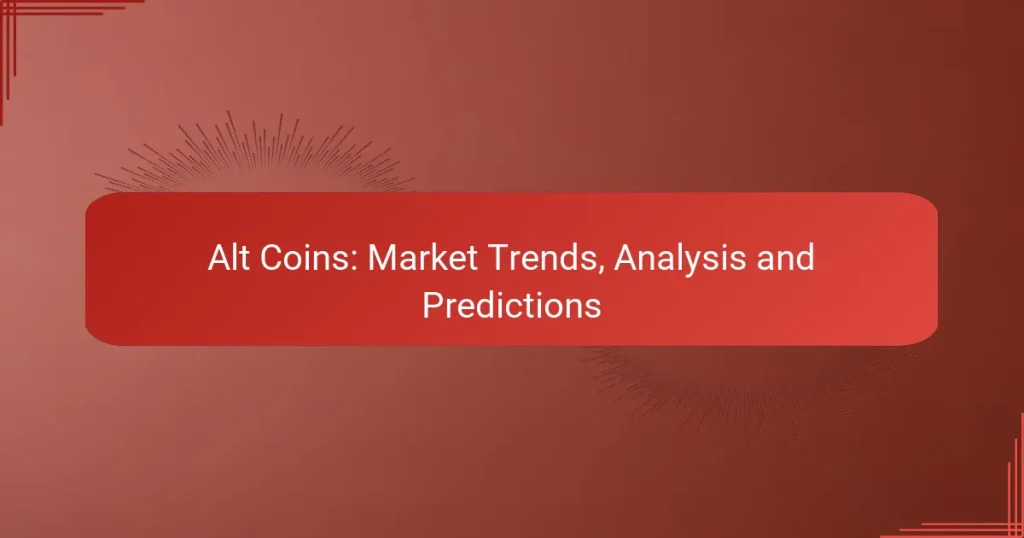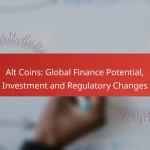In 2023, the altcoin market is experiencing notable transformations fueled by institutional investments and the growth of decentralized finance (DeFi). With the emergence of Layer 2 solutions, altcoins are gaining traction among both retail and institutional investors, showcasing a maturing landscape. Unlike Bitcoin, altcoins often display higher volatility and unique price dynamics influenced by various market factors, making them an intriguing area for analysis and investment.
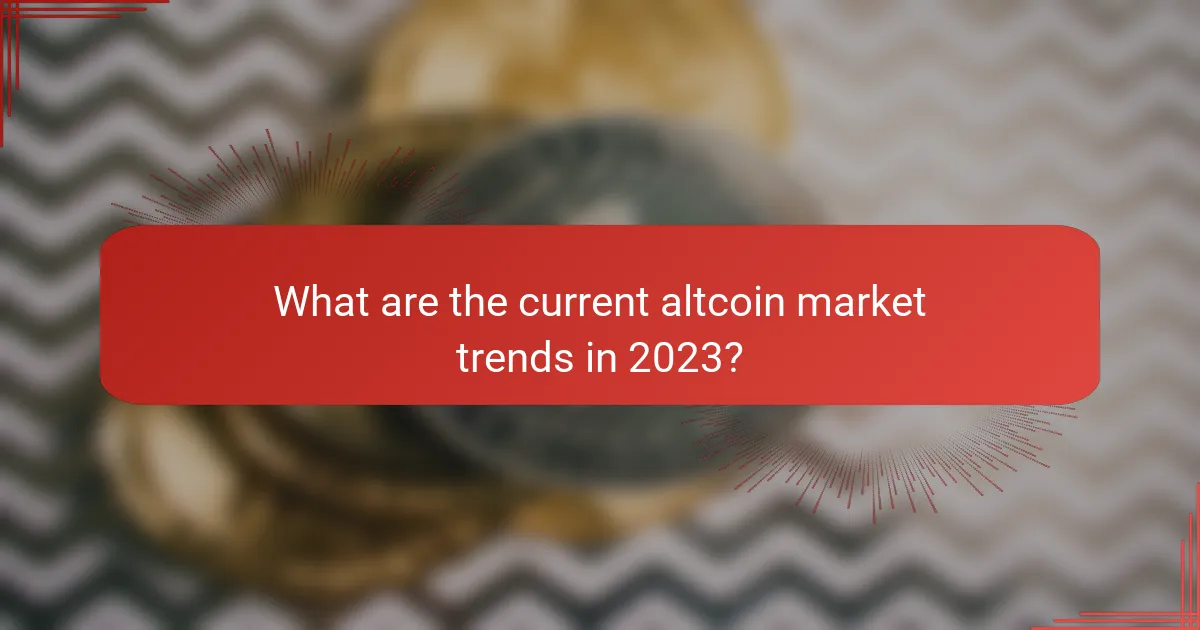
What are the current altcoin market trends in 2023?
In 2023, the altcoin market is characterized by significant shifts driven by institutional investments, the rise of decentralized finance (DeFi), and the development of Layer 2 solutions. These trends indicate a growing maturity in the altcoin space, attracting both retail and institutional investors.
Increased institutional investment
Institutional investment in altcoins has surged, with many hedge funds and investment firms diversifying their portfolios beyond Bitcoin and Ethereum. This trend is driven by the potential for higher returns and the increasing acceptance of cryptocurrencies as a legitimate asset class.
Investors are particularly interested in altcoins that show strong use cases, such as those focused on smart contracts, privacy, and interoperability. Institutions often conduct thorough research before investing, looking for projects with solid fundamentals and active development teams.
Growing DeFi adoption
The decentralized finance (DeFi) sector continues to expand, with altcoins playing a crucial role in this growth. DeFi platforms allow users to lend, borrow, and trade assets without intermediaries, leading to increased liquidity and accessibility in the market.
Popular DeFi altcoins like Uniswap and Aave have seen significant adoption, enabling users to earn yields and participate in governance. As more users become familiar with DeFi, the demand for altcoins that support these protocols is likely to rise.
Emergence of Layer 2 solutions
Layer 2 solutions are gaining traction as a means to enhance scalability and reduce transaction costs on existing blockchain networks. These solutions, such as Polygon and Optimism, allow for faster transactions and lower fees, making altcoins more appealing for everyday use.
Investors should consider the potential of Layer 2 altcoins, as they address critical issues faced by major blockchains. The integration of these solutions can lead to increased adoption and utility, positioning these altcoins favorably in the market.
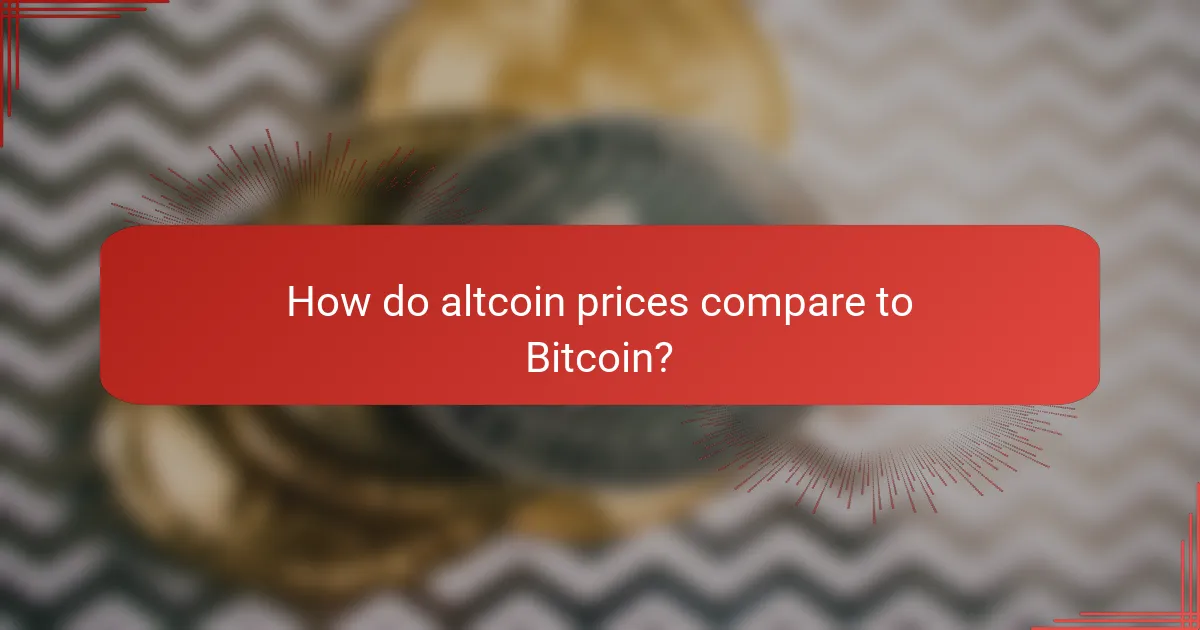
How do altcoin prices compare to Bitcoin?
Altcoin prices often exhibit significant differences compared to Bitcoin, primarily due to their lower market capitalization and higher volatility. While Bitcoin serves as the benchmark for the cryptocurrency market, altcoins can experience rapid price fluctuations influenced by various factors, including market sentiment and technological developments.
Higher volatility in altcoins
Altcoins typically show greater volatility than Bitcoin, meaning their prices can rise or fall sharply within short timeframes. This volatility can be attributed to factors such as lower liquidity, smaller market sizes, and speculative trading. For instance, while Bitcoin might experience a price change of a few percentage points in a day, some altcoins can see swings of 10% to 30% or more.
Investors should be cautious when trading altcoins due to this unpredictability. It’s advisable to conduct thorough research and consider market trends before making investment decisions.
Market cap differences
The market capitalization of Bitcoin is significantly higher than that of most altcoins, which affects their price stability and growth potential. Bitcoin often dominates the market, holding a market cap that can be several times larger than the next largest altcoin. For example, while Bitcoin might have a market cap in the hundreds of billions, many altcoins operate in the lower billions or even millions.
This disparity means that altcoins can be more susceptible to large price movements based on market sentiment or news. Investors should be aware of these differences when diversifying their portfolios.
Correlation with Bitcoin price movements
Altcoin prices often correlate with Bitcoin price movements, meaning that when Bitcoin rises or falls, many altcoins tend to follow suit. This correlation can be strong during market-wide trends, where investor sentiment towards Bitcoin influences the entire cryptocurrency market.
However, some altcoins may decouple from Bitcoin’s price at times, especially if they have unique developments or news that attract investor interest. Monitoring Bitcoin’s performance can provide insights into potential altcoin price movements, but investors should also consider individual altcoin fundamentals.
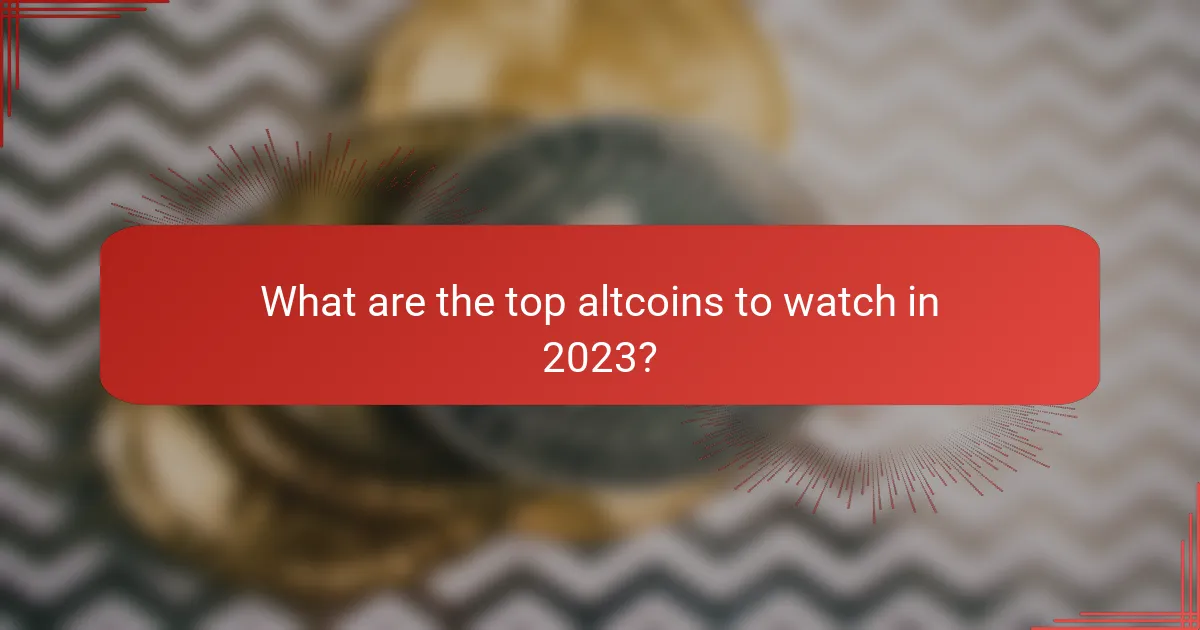
What are the top altcoins to watch in 2023?
In 2023, several altcoins stand out due to their unique features and market potential. Ethereum, Cardano, and Solana are among the top contenders, each offering distinct advantages that cater to different needs within the cryptocurrency ecosystem.
Ethereum (ETH) for smart contracts
Ethereum remains the leading platform for smart contracts, enabling developers to create decentralized applications (dApps) with ease. Its robust ecosystem supports a wide range of projects, from finance to gaming, making it a versatile choice for developers and investors alike.
When considering Ethereum, keep in mind its transition to a proof-of-stake model, which aims to improve scalability and reduce energy consumption. This shift could enhance transaction speeds and lower fees, making it more attractive for users.
Cardano (ADA) for scalability
Cardano is designed with scalability in mind, utilizing a unique proof-of-stake consensus mechanism called Ouroboros. This allows the network to process transactions efficiently, making it suitable for large-scale applications.
Investors should consider Cardano’s focus on academic research and peer-reviewed development, which may lead to more robust and secure solutions. Its gradual rollout of features ensures that each upgrade is thoroughly tested, potentially reducing risks associated with new technologies.
Solana (SOL) for speed
Solana is known for its exceptional transaction speeds, capable of processing thousands of transactions per second. This high throughput makes it an appealing option for developers looking to build fast and responsive dApps.
However, while Solana’s speed is impressive, potential investors should be aware of its relatively young ecosystem compared to Ethereum and Cardano. The platform’s growth and adoption will be crucial in determining its long-term viability in the competitive altcoin market.

What factors influence altcoin price predictions?
Altcoin price predictions are primarily influenced by market sentiment, technological advancements, and regulatory changes. Understanding these factors can help investors make informed decisions about their altcoin investments.
Market sentiment analysis
Market sentiment refers to the overall attitude of investors toward a particular altcoin or the cryptocurrency market as a whole. Positive sentiment can drive prices up, while negative sentiment can lead to declines. Tracking social media trends, news coverage, and community discussions can provide insights into prevailing market attitudes.
Tools like sentiment analysis platforms can quantify market mood, often using metrics such as fear and greed indices. Investors should be cautious, as sentiment can shift rapidly, impacting altcoin prices significantly in short timeframes.
Technological developments
Technological advancements play a crucial role in shaping altcoin prices. Innovations such as upgrades, new features, or partnerships can enhance an altcoin’s utility and attractiveness, leading to price increases. For instance, a successful network upgrade may improve transaction speeds, which can positively influence investor confidence.
Investors should monitor project roadmaps and development updates to gauge potential impacts on price. Engaging with developer communities and following relevant news can help identify promising technological shifts before they affect market prices.
Regulatory impacts
Regulatory changes can have immediate and profound effects on altcoin prices. New regulations may either restrict or promote the use of certain altcoins, influencing investor behavior. For example, favorable regulations in a major market like the EU or the US can lead to price surges, while strict regulations can cause sharp declines.
Staying informed about regulatory developments is essential for altcoin investors. Following updates from regulatory bodies and understanding local laws can help anticipate market reactions and avoid potential pitfalls associated with compliance issues.
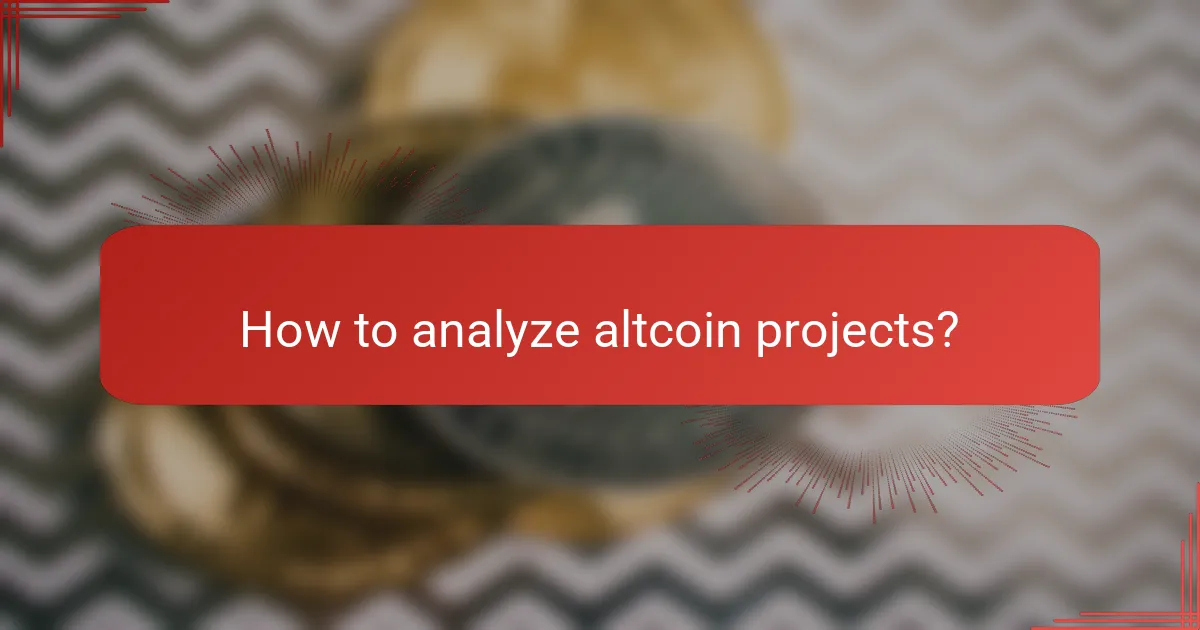
How to analyze altcoin projects?
To analyze altcoin projects effectively, focus on their whitepapers, the credentials of their teams, and community engagement metrics. These elements provide insight into the project’s viability, potential for growth, and overall credibility.
Evaluating whitepapers
Whitepapers serve as the foundational documents for altcoin projects, detailing their purpose, technology, and roadmap. A strong whitepaper should clearly explain the problem the project aims to solve and how it plans to achieve its goals.
Look for technical clarity, realistic timelines, and a well-defined use case. Avoid projects with vague descriptions or overly ambitious promises without supporting data. Key sections to focus on include the introduction, technology overview, and tokenomics.
Assessing team credentials
The success of an altcoin project often hinges on the expertise and experience of its team. Research the backgrounds of key team members, including their previous projects, relevant industry experience, and any notable achievements.
Check for transparency regarding team members and their roles. A project with a publicly available team profile and verifiable credentials is generally more trustworthy. Be cautious of anonymous teams or those with limited information available.
Community engagement metrics
Community engagement is a vital indicator of an altcoin’s potential success. Metrics such as social media following, forum activity, and community sentiment can provide insight into the project’s popularity and user support.
Evaluate platforms like Twitter, Reddit, and Telegram for community discussions and feedback. A strong, active community can drive adoption and provide valuable insights into the project’s direction. Look for consistent engagement rather than short-term spikes in activity.
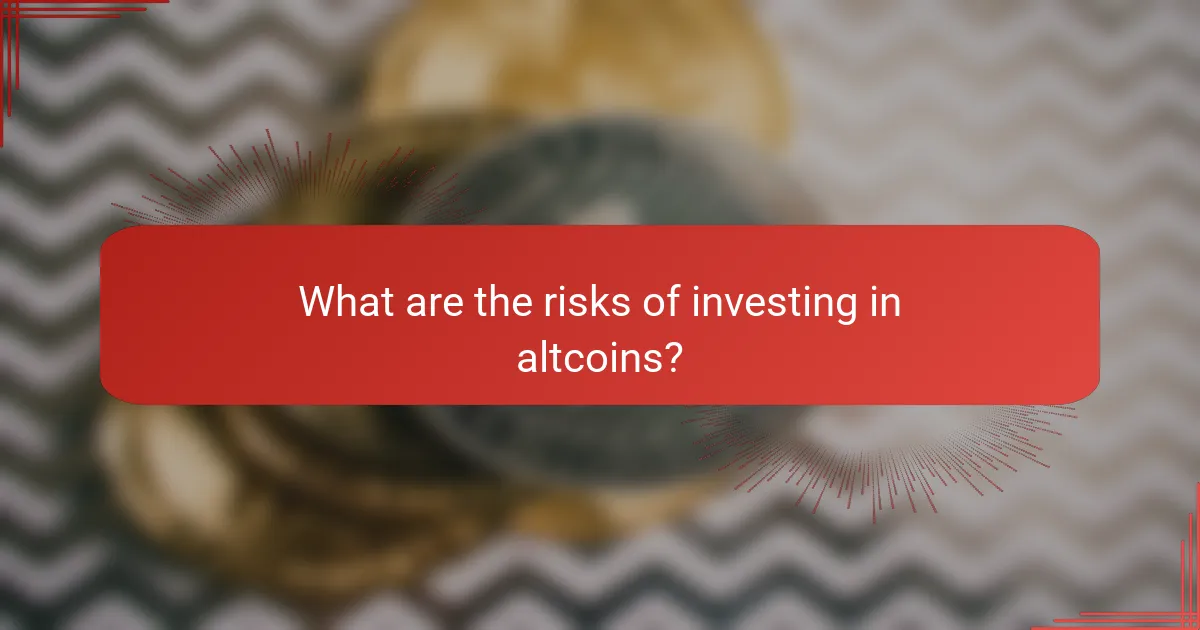
What are the risks of investing in altcoins?
Investing in altcoins carries several risks that potential investors should consider. These include regulatory uncertainty, market manipulation, and technological vulnerabilities, all of which can significantly impact the value and stability of altcoins.
Regulatory uncertainty
Regulatory uncertainty refers to the lack of clear guidelines governing altcoins, which can lead to sudden market changes. Different countries have varying stances on cryptocurrencies, with some imposing strict regulations while others remain more lenient. This inconsistency can create a volatile environment for investors.
For instance, if a country decides to ban or heavily regulate altcoins, it can lead to sharp declines in their value. Investors should stay informed about the regulatory landscape in their region and globally to mitigate risks associated with sudden policy changes.
Market manipulation concerns
Market manipulation is a significant risk in the altcoin space due to lower liquidity compared to major cryptocurrencies like Bitcoin. This can lead to price manipulation through tactics such as pump-and-dump schemes, where the price is artificially inflated before being sold off by manipulators.
Investors should be cautious of altcoins with low trading volumes and be wary of sudden price spikes that may indicate manipulation. Conducting thorough research and relying on reputable exchanges can help reduce exposure to these risks.
Technological vulnerabilities
Technological vulnerabilities in altcoins can arise from flaws in their underlying blockchain technology or smart contracts. These vulnerabilities can be exploited by hackers, leading to significant financial losses for investors.
For example, poorly coded smart contracts can be susceptible to attacks, resulting in the theft of funds. Investors should prioritize altcoins with a strong development team and a proven track record of security audits to minimize the risk of technological failures.
